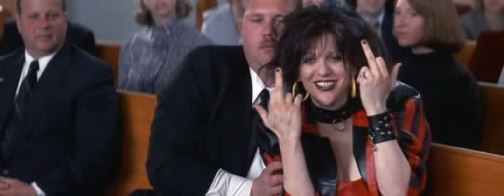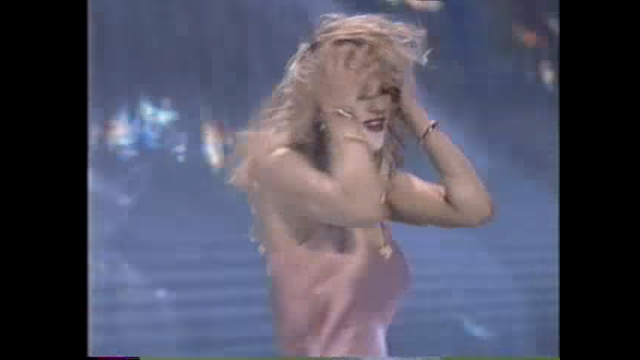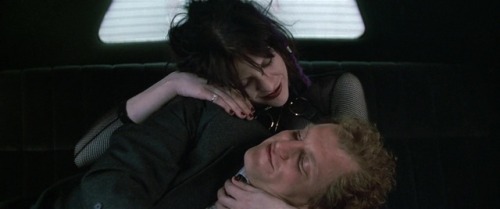
The image that most people had of Courtney Love in 1995 ran parallel to how she presented herself during the MTV Video Music Awards that same year. She picked fights with Madonna, who claimed Courtney just wanted attention, and later she flashed her ass to paparazzi on her way out. She was a fuck up who appeared to be wasted 24/7, but the image of Courtney Love has always been more complicated than surface level assertions by reporters and papparazzi. That’s been the way with her ever since Vanity Fair published a hit piece on Love asserting that she did heroin while she was pregnant with her soon to be daughter, Frances Bean Cobain. No one’s ever really taken the time to empathize with her and the agony that lay within. That part of her image, was saved for the stage when Hole performed, “Violet” that evening.
Courtney stood there wearing a tattered pink baby doll dress. Her eyeliner blackened beyond all recognition standing out against her ghostly pale face. The paleness and her body language in those opening seconds of silence are haunting. She approaches the microphone and in a droning voice, she says this one is for Kurt and Kristen and River and all the other lost souls of the 1990s. She stares out into a sea of people for a moment before clasping the microphone and glancing downward, pulling herself up for the performance and all it takes for Courtney to come alive is a few chords. She screams, throws her body around, barely keeping her voice in tune and scraping against the limits of her lungs and throat like nails on sandpaper. It’s an astoundingly physical performance. After the better part of a year of grieving the one person she loved above all else, this is a catharsis. She hurts and every single time she screams it echoes out beyond the veil of a TV screen, begging you to listen to this torrential release of everything she’d been keeping inside. “Go on take everything” as if a dare to the world that she’s already been dealt her worst blow, what else could you possibly do to hurt me? Damaged girls feel seen. During this song she doesn’t seem wasted, but she carries the wounds of the past in her body and during “Violet” it feels like she may fall apart or combust at any moment. When the song’s over she drives away at a few repeating chords and howls “god bless your soul” before hurling her guitar into the drum kit. There’s a stray image of Courtney caught by the cameras before they cut to break where she grasps up at her hair with a pained expression on her face. What do you do after the music stops? What can you do when the music isn’t enough?


Courtney Love is both these images. She carries that in her persona in everything she does. The damaged feminine, a tattered angel, someone with a deep insularity and loneliness because no one’s ever been there for her without it falling apart. No one ever expected much different from Courtney Love in 1995 other than the rockstar death wish she seemed to carry with herself, but that all changed for a brief moment when Love become more than just a musician in Milos Forman’s The People vs. Larry Flynt.
Courtney Love had dabbled in acting a bit before performing in Forman’s film, but it was mostly relegated to side characters in Alex Cox films during the 1980s where she was given little space to make much of an impact. This was years before she had created an image of herself as the frontwoman of Hole and been dubbed the Yoko Ono of grunge, by shit-head rock fans who blamed her for the death of her late husband Kurt Cobain. Courtney Love always wanted to be an actor, but after years of confirmed drug usage and suspected substance abuse in other instances she was a risk to hire. Milos Forman fought for her, because he knew she was perfect for the role of Althea Flynt and had a unique screen presence in her own right. Forman put up one million dollars of his own money to insure that she’d be drug tested and meet the strict guidelines of Columbia Pictures while the film was being shot. He took a chance on Courtney Love and it paid off.
In a way Courtney Love was made to play Althea Flynt, because Althea and Courtney lived similar lives. They both had trouble in their upbringing from abusive parental situations and went in and out of foster homes until they decided to strike out on their own in an uncaring world. They both lit the flame at both ends in their work and home-life and both were brilliant at what they did. By not so secretly coding the Althea Flynt character as a veiled version of Courtney Love it allowed Courtney to inject her own real life personae, built upon anarchic femininity, into the character. The type of acting that’s built by creating a unique personae is extremely difficult to maintain and while old Hollywood was built upon the strength of all the greats who understood their own brand and how to convey that outwards in an appealing and seductive manner it wasn’t nearly as ripe in the 1990s. MTV fundamentally changed how we perceived screen stars with the advent of the music video which allowed for musical artists such as Madonna and Prince to become the new screen legends of their time. When you take the MTV model and apply it to rock music iconography and status built upon controversy, such as the case with Courtney Love, it hitches the performance to a set of expectations one can expect. It was shrewd casting on Forman’s part to crystallize this notion into a movie which tapped into everything that made Courtney Love a dangerous, seductive, damaged force of womanhood in the mainstream. That Courtney got to funnel all of this into her character and play off Woody Harrelson’s portrait of Larry Flynt as a walking talking middle finger was an added bonus. Love and Harrelson are mesmerizing to watch, because they shouldn’t be lead actors. They’re too weird, too specific, and in Love’s case too prone to explosiveness in her own life, but then Althea and Larry shouldn’t have been iconic public figures either.
The first time we see Courtney Love in The People vs. Larry Flynt she’s stripping in Larry’s club, and shoving her ass into the camera, just like at the 1995 MTV Video Music Awards. It’s an inauspicious debut for her in mainstream movies, but it’s also totally her. You don’t get the sense that she’s a special actor until the following scene when Althea and Larry discuss the legality of her stripping in his club due to her being underage. They have immediate chemistry and unlike her stripping, which is purposefully robotic and unsure, her seduction of Larry in his own office is another story. She has him in the palm of his hand, making sure to lean into her own sexuality, words slipping out of her mouth like crushed velvet and gesturing to Larry that she’ll be legal “just like that, in one second” before snapping her fingers. She has him, completely and then she asks him a question: “if he ever fucks the girls in the club?” and that’s enough for Larry. He’s done for. In this scene Courtney Love completely overwhelms Woody Harrelson, which is exactly the point. Woody has the hyper-flustered body language of someone with an erection under his desk and Courtney plays the room with the knowledge that by making him feel that way she’d be in complete control. Courtney Love would usually play the guitar with one leg hiked up on an amplifier in a power stance. She didn’t care if you could see up her dress. She was putting her foot down that she owned this room and if you looked it’s because she wanted you to. She brings that to Althea who goes from merely getting Larry hard to marrying him in no time flat. She gets what she wants. She falls in love easy, but you get the sense that she wanted that to happen too.
In these opening scenes between Althea and Larry Courtney Love’s image as a rock star and a fuck-up that we’re more familiar with isn’t used in her technique, but she does so later. It’s light and day between the confident, boisterous, powerful woman we see running Hustler magazine along with Larry Flynt and the addict Althea would become later in the film. Both parts of Courtney’s image are used in The People vs. Larry Flynt, because the rise and fall structure of biopics is perfect for rock-stars who live floating on the ether of both at all times, and in Love’s case she does so with the amplifiers cranked up to eleven. The difference in her physical stature when Althea slips into drug usage as a side effect of Larry’s paralysis after a failed assassination attempt is staggering. Courtney Love becomes the Courtney Love we all know well, albeit one with black hair instead of her usual blonde. In court-rooms she laughs inappropriately, becoming child-like and seconds later vulgar. She can’t keep herself up on two feet and stumbles, shifting her body language to that of a wrecking ball. She did the same things when trying to interrupt Madonna’s interview at the ’95 VMA’s. Courtney Love finds that part of herself and weaponizes it in the performance which blurs the line between reality and fiction in Althea. By contrast, Harrelson opts for a transformative angle, changing the cadence of his speech and his own physicality when Larry becomes bound to a wheelchair. Woody’s choices are big, and Courtney’s introspective ones meld into a relationship that feels lived in and dynamic and as a fan of acting it is exciting to watch, because they’re working in completely separate modes, and both are doing it so well.

No one really expected Courtney Love to survive the 1990s. Everyone just assumed she’d go the way of Kurt one of these days and opt for oblivion instead of perseverance so the final image of Althea having drowned in a bathtub is a startling one, because it’s an image that could have been real in Courtney Love’s own life. Because Courtney Love opted to create Althea as an extension to herself this final image, becomes shocking and unnerving. The blurring of reality and fiction between Courtney Love and Althea forces that image to reach deeper, beyond the movie and become contextually relevant to Love’s own public and artistic image as a tortured woman martyr. No such model for who Courtney Love was had ever happened before in rock music, and the typical ending of rockstars going out before their time, for Love, only ever happens in The People vs. Larry Flynt. The most shockingly brilliant thing about Courtney Love’s performance is that she changed her image, by using every last bit of what people thought of her before burning it to ash as Althea Flynt. She opts to survive. She only died in fiction.
originally posted 11/26/2018
patreon
Be First to Comment